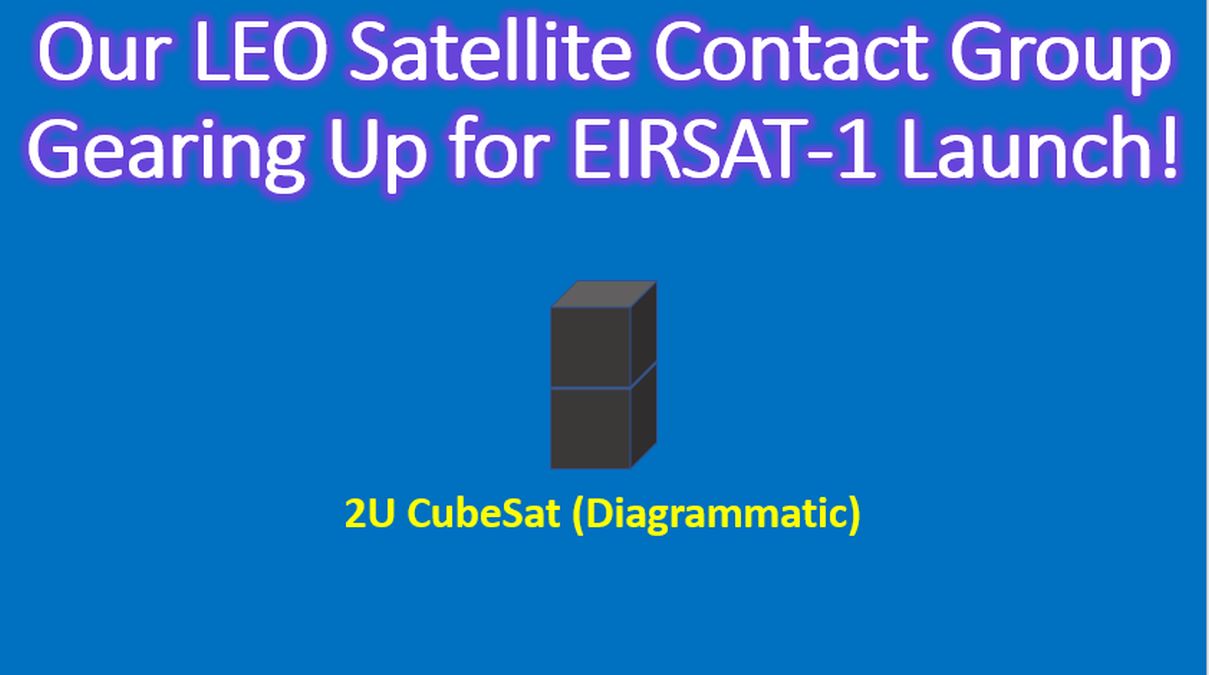Our LEO Satellite Contact Group Gearing Up for EIRSAT-1 Launch!
Our LEO Satellite Contact Group Gearing Up for EIRSAT-1 Launch!
Yesterday the news of the proposed launch of first ever satellite from Ireland, EIRSAT-1, was posted on our LEO Satellite Repeater Contact group. A lot of discussions followed as to how to monitor the satellite telemetry during the initial hours after launch. Usually we monitor LEO satellite FM voice transponders and try to have contacts through them. Some in the group also monitor weather satellites and post nice pictures. Still others have tried digipeaters on satellites like Amateur Radio on International Space Station, LEDSAT and IO-117. But receiving and decoding satellite telemetry soon after launch is quite challenging. My method of following the pass of the satellite is using the Argentinian Amsat website live display of Doppler shift. It will not be possible to use that method for a newly launched satellite.

Another website which I routinely use to find the path of satellite with respect to my location is the N2YO website. As expected, a search on that website for EIRSAT-1 did not return any results. Some in our LEO Satellite Repeater Contact group suggested using Eggbeater antenna as it is omindirectional and covers a good portion of the sky. But the big question was when to monitor the downlink frequency of 437.1 MHz? The student group who has built the satellite had asked for help from all who can monitor satellites, especially during the initial 18 hours after launch when it will not be receivable at their ground station. One among our group who was submitting data to the SatNOGS, an Open Source global network of satellite ground-stations mentioned that some information will be available there for initial path prediction. He had been using a cross-Moxon antenna on UHF for monitoring.
EIRSAT-1 is an abbreviation for Educational Irish Research Satellite 1, built by a team of students at University College Dublin, with support from academic and professional staff. EIRSAT-1 is a 2 unit CubeSat. In this context, 1U CubeSat has a form factor of 10 x 10 x 10 cm. So this should be double that size at 2U. Support from Education Office of the European Space Agency, under the educational Fly your Satellite! Programme is also very important for implementation of the project. Meanwhile I contacted my old classmate (non-ham) in Ireland who told me that the satellite is scheduled to be launched on 29th November 2023, citing local media report. The teams at UCD School of Physics and UCD College of Engineering had started the project way back in 2017!
Information on EIRSAT-1 Beacons and other data is available at the github.com page. But I found it to be quite technical as I am yet to decode any satellite telemtry! All I have heard on my FM amateur radio is the digipeater signals from ARISS. That digipeater is currently stowed. Of course, I have been able to decode SSTV transmissions from ARISS during the recent event and get some pictures. Yet I was comforted by the statement of the EIRSAT-1 team: “I don’t understand any of that! That’s okay! When we started building EIRSAT-1 we didn’t understand any of that stuff either!” So we have scope for improvement! They have mentioned that their Ground Station, relied heavily on GNU Radio, especially the gr-satellites module.
I am happy to note that one among our LEO satellite group has that already installed in his Linux machine, though he had not used it yet. gr-satellites has been mentioned as a GNU Radio out-of-tree module with a collection of telemetry decoders for Amateur satellites. Though I was a Linux enthusiast a couple of decades back, currently I do not have a Linux machine at home. EIRSAT-1 is prompting me to come back to Linux, more so because there a lot of open source Amateur Radio software out there for Linux! Hoping to post more on EIRSAT-1 and satellite telemetry monitoring soon as the launch date is nearing. We are as excited as the EIRSAT-1 team in anticipation of the lauch!
Update: Very glad to see that two VU scientists are involved in this project! It seems preliminary TLE data for CAS-9 was published on AMSAT website 4 days prior to launch. If preliminary TLE data is available, it should be possible to predict pass with applications like: https://www.satellite-calculations.com/TLETracker/SatTracker.htm.